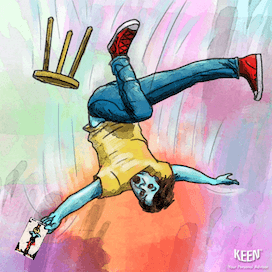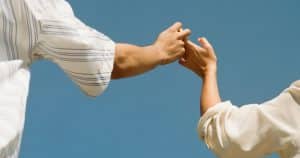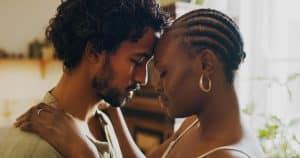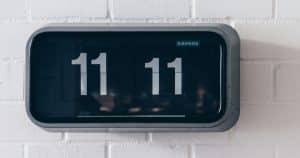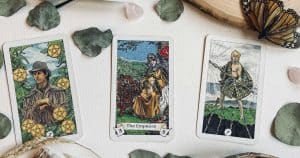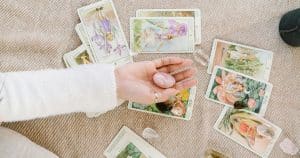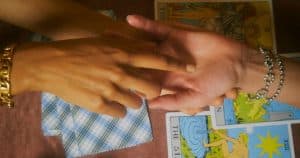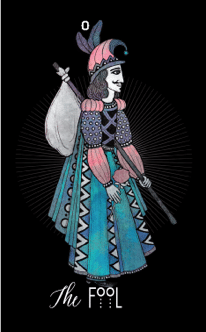Upside Down? The Pros and Cons of Reading Tarot Cards Reversed
I’ll be completely honest here: It took me years to interpret reversed tarot cards. I was well into being a professional reader before I decided I would add the upside-down cards to my readings under some circumstances.
Clients and students are often curious if they should or shouldn’t use reversed cards. It’s a purely individual choice, and you can read effectively both ways, including upright card interpretations. Here’s a look at the pros and cons of reading cards reversed.
The Meaning of Reversed Tarot Cards
In my experience, reading reversed tarot cards adds meaningful layers to a reading that can provide important insights for querents.
General Meanings of Reversals
When a card appears upside down in a spread, it often points to blocked energy, delays, internal resistance, or an unconscious aspect of the situation, which is crucial for understanding tarot card reversals.
Reversals can show us things that we may be avoiding or not ready to face. They frequently reveal an alternative perspective that encourages us to dig deeper into the card meanings.
Comparing Reversed and Upright Meanings
Reversed cards are often interpreted as the opposite or a lesser expression of the card’s upright meaning. For example, The Sun card upright indicates joy, success, and positivity. Reversed, The Sun can mean inner child work, delays on goals, or muted enthusiasm.
However, reversals don’t always mean the opposite – they can simply signal a more inward, private, or unconscious experience of the card’s energy compared to the external expression of the upright meaning.
Interpreting Reversals in Different Spreads
The position and spread used can greatly influence how I interpret a reversed tarot card. Here are some common spreads and how I approach reversals in each:
Yes/No Spreads
In simple yes or no spreads, a reversed card typically represents a “no” answer. If a card showing strong positive energy appears upright, I interpret that as an emphatic “yes”. Conversely, that same card reversed would suggest a definite “no”, illustrating the power of tarot card reversals. However, I always consider the card’s overall meaning along with its orientation.
Past/Present/Future Spreads
I often see clients surprised when a reversed card shows up in the Past position, but this offers tremendous insight. The past can greatly influence how we interpret current tarot card reversals.
For example, the reversed Ace of Cups in the past could indicate that a new relationship had a shaky start or the seeker had some major emotional blocks. In the Future position, the same reversal might point to inner work needed before fully embracing love. The future holds growth potential, especially when we read reversed tarot cards.
Celtic Cross Spread
The classic Celtic Cross spread provides 10 card positions, each with a specific meaning. I pay close attention to reversals in the “Challenges”, “Hidden Influences” and “Hopes/Fears” positions, as these are prime spots to uncover unconscious blocks, inner conflicts, or self-sabotage. Reversals in the Outcome position may suggest delays or a suboptimal result if the querent doesn’t address underlying issues.
The key to interpreting reversals in any spread is to consider both the card’s intrinsic meaning and how its energy may be internalized, delayed, or blocked based on its position and the question at hand. When I approach tarot reversals with curiosity rather than fear, I find they enrich my tarot readings with honest yet empowering messages about the card meanings.
The Upside of Upside Down
The tradition of reading cards reversed is a practical one: sometimes the cards appear upside down. At some point along the way, readers decided that if “fate” dealt a card reversed, it must be important. The most obvious interpretation would be to choose the opposite of the regular meaning. There’s nothing mystical about it—and this was one reason why I chose not to bother with reversed cards for years.
However, when energy is blocked, not flowing, or a client is in denial about something in their life, nothing brings that home as directly as a reversed card.
Susan had called in for three readings in a month. She was obviously going through a tough time with a relationship breakup. I had done two larger spreads for her but felt she wasn’t acting on the advice that had come through the cards. I decided to shuffle my deck with cards reversed, trusting that the right ones would show up as always.
I decided that a little tough love was in order. I told her we’d do a three-card spread and that she needed to start taking responsibility for her healing. I am always happy to help clients, but not to the extent that they depend on me to do the work for them—which is impossible anyway!
The spread for Past, Present, and Future can be examined alongside the energy of the card. was as follows:
• Past: 10 of Cups represents emotional fulfillment and joy in a tarot deck, especially when drawn upright. The card reversed, can signify the opposite of the card’s meaning, a key aspect in the method of reading reversals.
• Present: 8 of Swords
• Future: Ace of Cups
This turned out to be a powerful medicine for Susan. When I told her about the reversed card in the Past position, she was confused at first. I told her it was likely the relationship had not been as idyllic as the vision she was remembering and holding onto. The 10 Cups showing upside down suggested there was a block to true happiness or that happiness was illusory or not achieved. If you visualize 10 cups upside down, what is happening? Liquid spilling out—and empty cups!
Susan broke down in a way she hadn’t in previous readings. I gently guided her to intuitively explore her feelings and how they might relate to the reversed cards. It was true, the relationship had been far from happy; she realized that her perception was the opposite of the card’s meaning she had associated with him. With the power of that one reversed card, she was able to open up to her truth and deal with the shame, disappointment, and heartbreak.
The other benefit to reading reversed cards is to add the inner dimension of the querent, especially in spreads where there is no specific card position to represent the inner mindset.
For example, in bigger spreads, like the Celtic Cross and the Inner Work, there are places to indicate the subconscious mind or inner beliefs of the client. But in three-card spreads, or yes/no layouts, you may need a reversed card (if it appears) to show the client’s inner (possibly unconscious) state of mind or a “no” answer.
In the above example, we could have looked at the layout as Mind, Body, and Spirit while considering the meaning of the card.
The 10 of Cups would then denote that in the past, the client had not truly been happy, but she was unable to admit it. She believed that she should be happy; but though others may have found her relationship perfect, that wasn’t true for her inside. This may have created a lot of mental conflict regarding the energy of the card.
Both methods reveal essentially the same meaning but in slightly different ways. If the 8 of Swords had been reversed, it could have meant that she was pretending to be fine on the outside now and moving on, but inside she was still trapped by limiting beliefs and self-illusion.
A Simple Exercise
Try a three-card spread for yourself on an issue that is important but not emotionally charged for you.
- Choose an issue that is important to you but not emotionally charged.
- Shuffle your tarot deck, ensuring that some cards are upside down so that reversed cards are a possibility in your spread.
- Pull three cards from the shuffled deck and lay them out in front of you.
- Note which cards, if any, are reversed (upside down).
- Assign the first interpretation to the three cards: Past (left), Present (middle), and Future (right). Consider the meaning of each card in its assigned position, paying special attention to any reversed cards.
- Now, reinterpret the spread using a second set of meanings: Mind (left), Body (middle), and Spirit (right). Observe how the interpretation of the reversed cards may change based on this new context.
- Apply a third set of meanings to the cards: Subconscious (left), Conscious (middle), and Superconscious (right). Once again, note any shifts in the interpretation of the reversed cards.
- If you didn’t draw any reversed cards, intentionally turn one or more cards upside down and see how it affects the interpretation of the spread.
- Experiment further by reversing each card individually and observing how it changes the overall meaning of the reading.
- Throughout the process, use your intuition to guide your interpretations and be open to the different shades of meaning that arise from the upside-down images.
Use your intuition to let you perceive different shades of meaning. You will begin to see how the upside-down images speak to you.
When Reversed Cards Aren’t Useful
I find that there are enough cards in the deck to communicate specific energy (positive, negative, open, blocked) that reversed cards aren’t really necessary. They can add a dimension of confusion and anxiety for beginning readers or for clients. Some cards are hard to read reversed—especially some of the Major Arcana.
As you evolve as a Tarot reader, you will internalize the spectrum of meaning for each card, from negative to positive. Your intuition will guide you as to how that energy is being embodied or called forth from the client (or yourself).
Larger spreads that contain placements for a wide variety of emotional states will usually cover what isn’t working, what is internalized, or what is blocked. Reversed cards in these spreads can just muddy the water.
However, I do recommend that as you play with your cards, you experiment with reading them reversed. It is an individual choice when it comes to how one chooses to read reversals. Allow your reading to evolve, and trust that if and when it’s time to use reversed cards, you’ll know it.
Do you need help interpreting reversed cards in a reading? Would you like to experience a professional reading with the possibility of reversed cards? Call an advisor on Keen today and tell them you are curious about the upside-down world of the Tarot.
